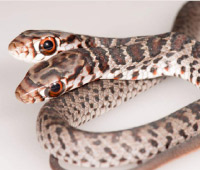Signs and Portents In Florida
 |
|
Dos, the rare, two-headed Black Racer snake is doing just fine with the Florida Fish and Wildlife folks. |
Well, would you look at what the cat dragged in?
A Florida woman says her daughter’s cat Olive caught a rare two-headed snake slithering around outside her Palm Harbor home and plopped it down in the living room.
Now, wildlife officials are caring for the reptile in hopes of giving it a fighting chance.
Kay Rogers said she and her family initially thought the snake was injured when they found it, then when her daughter scooped it up to take a closer look, they realized it was something much more bizarre.
“Originally I thought my daughter was kidding when she said that. Then I saw him and was amazed. I had never seen anything like that,” Rogers said.
Her daughter, who loves nature and animals, was intrigued and started doing research. She also named the snake Dos.
“So of course because it is her cat, Olive, she said, ‘See mom? Olive brought him inside because she knew we would save him,’” Rogers said.
From there, Rogers turned to a snake identification group on Facebook.
“Our cat brought this guy inside, I am wondering if I should let him go or contact a rescue. We watched him for a bit to make sure he wasn’t injured but he doesn’t move around very well. Has anyone had experience with a two headed snake?” she wrote in September, not long after it was found.
Commenters were quick to offer advice and let her know that it was a two-headed black racer and the odds of surviving back in the wild were slim to none.
Not willing to give up, Rogers then contacted The Florida Fish and Wildlife Conservation Commission Research Institute and officials there agreed to help out.
In the meantime, she set up a habitat where Dos lived for a few days before Jonathan Mays from FWC came to get it on September 27.
The Research Institute posted pictures showing the snake and explaining more about its condition.
“This phenomenon, termed bicephaly, is uncommon but happens during embryo development when two monozygotic twins failed to separate, leaving the heads conjoined onto a single body. Both head’s tongue flick and react to movement, but not always in the same way,” FWC said.
The problem is, both brains act and think independently, making it difficult for the snake to eat and escape from predators. Because of that, two-headed creatures are unlikely to survive long in the wild.
Now, Rogers is glad that Dos is with the experts.
“We are happy to have found him and had him as a little part of our family. I feel like we found him the best place to thrive. We really hope he does,” she said. “They’ve taken such good care of him and we are happy he’s doing so well.”